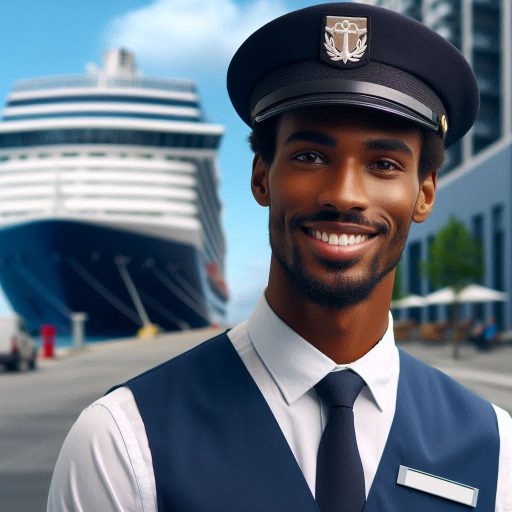Introduction
Cruise ships are floating cities where people from all over the world work together.
The diversity of cruise ship crew members is an essential aspect of the industry’s global nature.
Onboard, cultural diversity is more than just a mix of nationalities; it enriches interactions and teamwork.
Cultural diversity refers to the presence of different cultures, beliefs, and values within a group. In a globalized world, it has become increasingly important.
Cruise ships, which travel to multiple countries, thrive on cultural diversity, creating an environment where crew members share and learn from each other.
This blog post focuses on the cultural diversity found among cruise ship crew members.
We will explore how diverse backgrounds contribute to the unique work environment on board.
From communication challenges to learning opportunities, cultural diversity influences every aspect of life at sea.
The rich variety of languages, traditions, and work styles create both opportunities and challenges for crew members.
We will also discuss how cruise lines manage cultural diversity and how it impacts crew cohesion and guest service.
The presence of so many different cultures requires understanding, flexibility, and effective communication.
This diversity not only strengthens the crew but also enhances guest experiences, as passengers interact with a team that mirrors the world’s variety.
By the end of this blog post, you will gain a better understanding of why cultural diversity is crucial for cruise ship operations.
It brings new perspectives, fosters innovation, and helps crew members adapt to an ever-changing environment.
Cultural diversity among cruise ship crew members is a core strength that allows them to work harmoniously across oceans and cultures.
Overview of the Cruise Industry
A brief history of the cruise industry
The cruise industry has a rich history that dates back to the mid-19th century.
The first leisure cruises emerged as an extension of transatlantic voyages, catering to wealthy passengers seeking luxury travel.
In the 1960s, modern cruising transformed into a vacation option for the masses, with companies like Carnival and Royal Caribbean leading the way.
Today, the cruise industry attracts millions of travelers annually.
The significance of cruise ships in the global travel industry
Cruise ships play a significant role in the global travel industry.
Transform Your Career Today
Unlock a personalized career strategy that drives real results. Get tailored advice and a roadmap designed just for you.
Start NowThey offer an all-inclusive vacation experience, combining travel, lodging, dining, and entertainment.
Cruises stimulate local economies by bringing tourists to port cities, benefiting businesses and tourism sectors worldwide.
Additionally, cruises cater to a diverse range of travelers, including families, couples, and adventure seekers.
The multinational nature of cruise ships and their crew members
Cruise ships are inherently multinational, both in terms of passengers and crew members.
Onboard, you’ll find people from various cultural and linguistic backgrounds.
This diversity enhances the guest experience, allowing travelers to engage with different cultures without leaving the ship.
For crew members, the industry offers employment opportunities regardless of nationality, fostering a global workforce.
The cruise industry operates like a floating international community, with workers from over 100 countries.
Crew members come from nations across Asia, Europe, Africa, and the Americas, each contributing their unique skills and experiences.
This cultural diversity enriches the work environment and encourages the exchange of ideas and traditions.
It also helps ships cater to passengers from different regions of the world, creating a more inclusive and welcoming atmosphere.
In summary, the cruise industry’s rich history, global significance, and multicultural nature make it a dynamic part of the travel sector.
This diversity strengthens both the crew’s operations and passengers’ overall experience.
Read: The Benefits of Continuous Learning in Advertising Design
Role of Cultural Diversity on Cruise Ships
Creating a Welcoming Environment for Passengers
Cultural diversity plays a crucial role in creating a welcoming and inclusive environment for passengers on cruise ships.
When passengers see crew members from various cultural backgrounds working together harmoniously, it sends a powerful message of unity and acceptance.
This diversity enhances the overall guest experience and makes passengers feel valued and respected.
Contributing to a Unique Guest Experience
The cultural diversity among crew members adds a unique and enriching element to the guest experience.
Passengers have the opportunity to interact with individuals from different parts of the world, learn about different customs, traditions, and languages, and broaden their cultural horizons.
This exposure to diversity creates memorable and impactful experiences for passengers during their cruise.
Transform Your Career Today
Unlock a personalized career strategy that drives real results. Get tailored advice and a roadmap designed just for you.
Start NowForming a Cohesive Team
On board a cruise ship, crew members from diverse cultural backgrounds come together to form a cohesive and efficient team.
Despite their differences, they share a common goal of providing exceptional service to passengers and ensuring their safety and comfort.
The blend of various perspectives, skills, and experiences contributes to the overall success of the crew and enhances the overall operation of the ship.
Read: What to Expect During Cruise Ship Staff Orientation
Cultural Exchange Opportunities for Crew Members
The cultural exchange programs available for cruise ship crew members
Cruise ships are floating microcosms, with crew members hailing from diverse cultures and countries.
Many cruise lines offer cultural exchange programs designed to enhance the onboard experience by fostering cross-cultural interactions among crew members.
These programs include language classes, cultural workshops, and themed social events that celebrate different traditions.
Crew members get the opportunity to share their heritage while learning about others, creating a more harmonious and inclusive environment.
Personal stories or testimonials from crew members about their experiences with cultural exchange
Personal stories from crew members highlight the transformative nature of cultural exchange onboard.
For example, a crew member from the Philippines shared how a culinary exchange program allowed him to teach others about Filipino cuisine, while learning about Mediterranean cooking in return.
Another crew member from Italy expressed that participating in cultural festivals organized onboard helped him build lasting friendships with colleagues from across the globe.
These experiences help crew members feel more connected, even while being far from home.
How these programs promote understanding and respect among crew members from different backgrounds
Cultural exchange programs promote mutual respect and understanding among crew members from diverse backgrounds.
By participating in these activities, crew members are encouraged to embrace cultural differences and appreciate each other’s traditions.
This not only fosters a positive work environment but also helps break down stereotypes and misunderstandings.
Crew members learn how to effectively communicate across cultural boundaries, contributing to a more collaborative team atmosphere.
As a result, these programs help create a sense of unity and belonging among crew members, despite their varying cultural origins.
Basically, cultural exchange opportunities on cruise ships provide valuable experiences for crew members, fostering inclusivity, respect, and understanding.
These programs allow crew members to connect on a deeper level, creating a strong, cohesive team that values diversity.
Read: What to Expect During Cruise Ship Staff Orientation
Transform Your Career Today
Unlock a personalized career strategy that drives real results. Get tailored advice and a roadmap designed just for you.
Start Now
Challenges of Cultural Diversity on Cruise Ships
Cultural diversity among cruise ship crew members creates both opportunities and challenges.
With crew members coming from various backgrounds, differences in language, traditions, and behaviors may arise.
These differences can lead to potential issues that must be addressed to maintain a harmonious work environment.
Identify Potential Challenges
Cultural differences can result in misunderstandings, miscommunication, and conflicts.
Language barriers can hinder collaboration, making it difficult for crew members to effectively communicate.
Varying work styles and expectations may create tension, as individuals might approach tasks differently.
Additionally, differing attitudes towards authority, time management, and personal space can complicate relationships on board.
Overcoming Communication Barriers
To address these challenges, fostering clear communication is essential.
Encouraging the use of a common language, such as English, can reduce misunderstandings.
Using simple, direct language and avoiding idioms helps minimize confusion.
Encouraging crew members to ask for clarification when needed ensures everyone understands the message.
Open communication platforms and regular team meetings also promote understanding and team cohesion.
Cultural Sensitivity Training
Cultural sensitivity training is crucial in overcoming these challenges.
It helps crew members understand and appreciate cultural differences, fostering mutual respect.
This training teaches individuals to recognize their biases and learn appropriate behaviors for interacting with people from different cultures.
It also emphasizes the importance of empathy, patience, and adaptability in a multicultural setting.
By addressing cultural diversity challenges, fostering open communication, and implementing cultural sensitivity training, cruise ship crews can create a more inclusive, harmonious work environment.
This approach ensures better teamwork, enhanced productivity, and a positive atmosphere on board, benefiting both crew members and passengers alike.
Read: How to Transition to Advertising Design from Another Field
Celebrating Diversity on Board
How cruise lines celebrate cultural diversity through onboard events and activities
Cruise lines embrace cultural diversity by organizing vibrant events and activities that celebrate various backgrounds.
Transform Your Career Today
Unlock a personalized career strategy that drives real results. Get tailored advice and a roadmap designed just for you.
Start NowThese celebrations create a unique and inclusive atmosphere on board, allowing passengers and crew members to connect through shared experiences.
By exploring different cultures, cruise lines enhance the overall travel experience for everyone.
Examples of cultural performances, themed nights, and culinary experiences on board
One of the key ways cruise lines celebrate diversity is through cultural performances, themed nights, and culinary experiences.
For example, many cruises host traditional dance performances from different countries, allowing passengers to witness unique art forms.
Themed nights, such as Caribbean or Mediterranean evenings, transport guests to different parts of the world through music, decor, and attire.
Culinary experiences also play a vital role, offering authentic dishes from around the globe, giving passengers a taste of different cuisines without leaving the ship.
The positive impact of these initiatives on passenger satisfaction and crew morale
These celebrations not only entertain but also positively impact both passengers and crew.
Passengers appreciate the opportunity to experience diverse cultures firsthand, making their trip more memorable.
Crew members, coming from different cultural backgrounds themselves, feel a sense of pride when their traditions are showcased.
This fosters a sense of unity and belonging among the crew, boosting their morale and job satisfaction.
All in all, celebrating cultural diversity on cruise ships strengthens the connection between passengers and crew members.
These events create a vibrant, inclusive environment that enhances the onboard experience.
Through performances, themed nights, and culinary offerings, cruise lines continue to celebrate diversity while positively impacting passenger satisfaction and crew morale.
Promoting Inclusivity and Equality
Efforts to promote inclusivity and equality among cruise ship crew members
Cruise lines are increasingly focusing on promoting inclusivity and equality among their crew members.
By fostering an inclusive culture, they ensure that all employees, regardless of background, feel respected and valued.
This commitment enhances team dynamics and creates a positive onboard experience for both crew and guests.
Initiatives for diversity training and policies that support a diverse workforce.
To support a diverse workforce, cruise lines implement diversity training programs.
These initiatives help crew members understand different cultures, fostering respect and cooperation among the team.
Policies promoting gender equality and anti-discrimination are enforced, ensuring fair treatment for all employees, regardless of nationality, ethnicity, or gender.
How diversity and inclusivity contribute to a positive work environment and overall success of the cruise industry
Diversity and inclusivity initiatives contribute significantly to the success of the cruise industry.
Transform Your Career Today
Unlock a personalized career strategy that drives real results. Get tailored advice and a roadmap designed just for you.
Start NowA workforce representing various cultures brings unique perspectives and ideas to the table.
This diversity enhances problem-solving, encourages innovation, and improves overall productivity.
Crew members who feel included and respected are more likely to be engaged, which boosts job satisfaction and retention.
A positive work environment, driven by inclusivity, also enhances the guest experience.
Guests onboard appreciate diverse cultures represented by the crew, making their stay more enriching.
Inclusivity promotes open communication, enabling crew members to collaborate more effectively and resolve issues quickly, contributing to smoother operations.
In essence, promoting inclusivity and equality among cruise ship crew members benefits both the employees and the company.
Diversity training, inclusive policies, and a supportive environment all play a role in driving the success of the cruise industry.
As cruise lines continue to prioritize inclusivity, they build a strong, unified workforce that contributes to their long-term growth and success.
Benefits of Cultural Diversity in the Cruise Industry
The advantages of having a culturally diverse crew on board
Cultural diversity brings immense value to the cruise industry, particularly within the crew.
Having a diverse team on board enhances the guest experience and creates a more inclusive atmosphere.
This diversity allows crew members to bring their unique backgrounds, perspectives, and skills to their roles, benefiting both passengers and the cruise line.
How diversity leads to innovation, creativity, and problem-solving in a team
A culturally diverse crew fosters innovation, creativity, and problem-solving.
When individuals from different cultures collaborate, they offer fresh ideas and alternative solutions to challenges.
This diversity in thought helps teams think outside the box and adapt to different situations more effectively.
By working together, they create more dynamic and effective solutions to common issues on board.
How a diverse workforce can attract a wider range of passengers and enhance the overall guest experience
Furthermore, a diverse workforce attracts a wider range of passengers.
Travelers from various backgrounds feel more comfortable when they see crew members who share similar cultures or speak their language.
This comfort level can lead to stronger connections between crew and guests, resulting in higher satisfaction rates and better reviews for the cruise line.
Passengers feel welcomed, understood, and valued, making their overall experience more enjoyable.
Transform Your Career Today
Unlock a personalized career strategy that drives real results. Get tailored advice and a roadmap designed just for you.
Start NowIn addition, a culturally diverse crew enhances the overall guest experience.
A blend of languages, customs, and traditions on board enriches the cruise atmosphere, offering passengers a unique and global experience.
Guests enjoy cultural exchanges and broaden their horizons, making their journey more memorable.
Ultimately, cultural diversity among cruise ship crew members offers numerous benefits, from increased creativity to a more inclusive guest experience.
This diversity not only strengthens the cruise team but also ensures a richer, more engaging environment for passengers.
Conclusion
Cultural diversity among cruise ship crew members is essential for creating a welcoming and inclusive environment on board.
It enhances the overall cruise experience for both crew and passengers.
Understanding and appreciating different cultures can lead to improved communication, teamwork, and mutual respect among crew members.
It also allows for better customer service and satisfaction.
Embracing cultural diversity contributes to a positive work environment, promotes tolerance, and fosters a sense of unity among crew members from various backgrounds.
It enriches the cruise ship industry as a whole.
As travelers, we should celebrate and value cultural diversity not only among cruise ship crew members but in all aspects of the travel industry.
It adds depth and richness to our experiences, fostering a spirit of openness and acceptance.
Cultural diversity is not just a buzzword but a fundamental aspect of creating a vibrant and harmonious cruising environment.
Let’s continue to embrace and cherish diversity in all its forms, making the journey more meaningful and memorable for everyone on board.
[E-Books for Sale]
The Big Book of 500 High-Paying Jobs in America: Unlock Your Earning Potential
$19.99 • 500 High-Paying Jobs • 330 pages
Explore 500 high-paying jobs in America and learn how to boost your career, earn more, and achieve success!
See All 500 High-Paying Jobs of this E-Book
1001 Professions Without a Degree: High-Paying American Jobs You Can Start Now
$19.99 • 1001 Professions Without a Degree • 174 pages
Discover 1001 high-paying jobs without a degree! Unlock career tips, skills, and success strategies for just $19.99!




